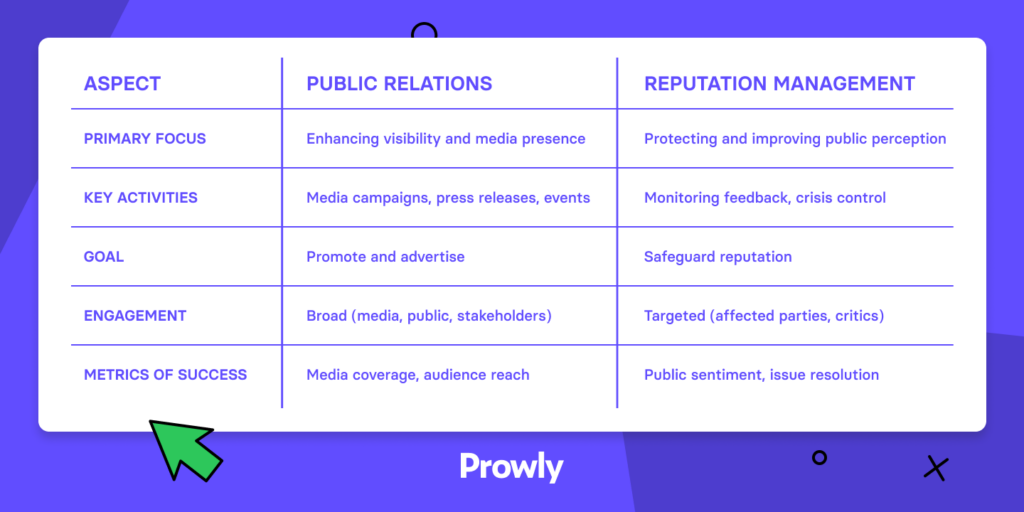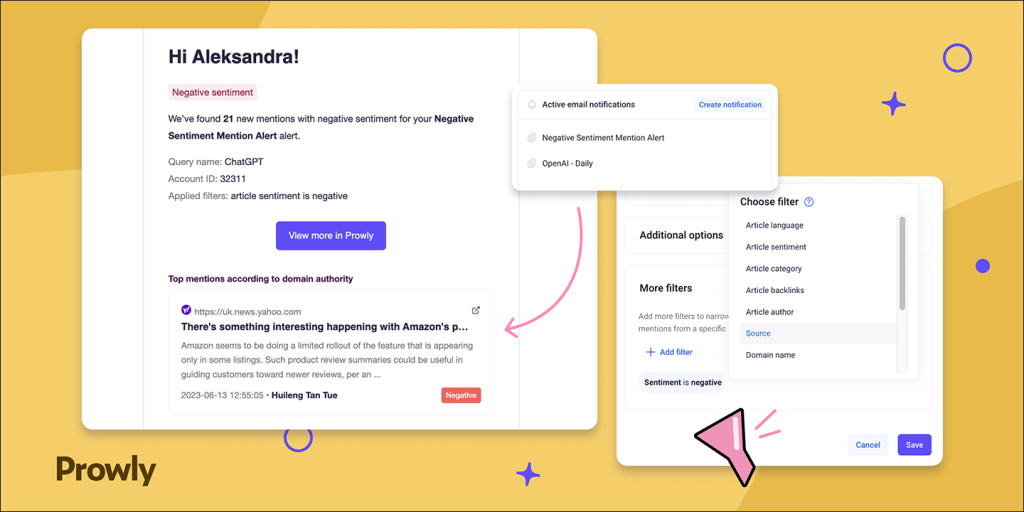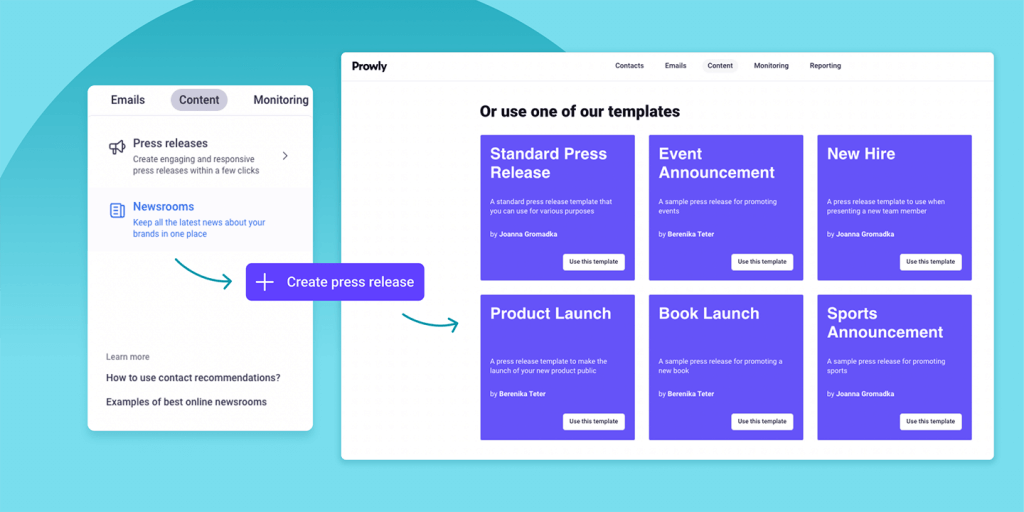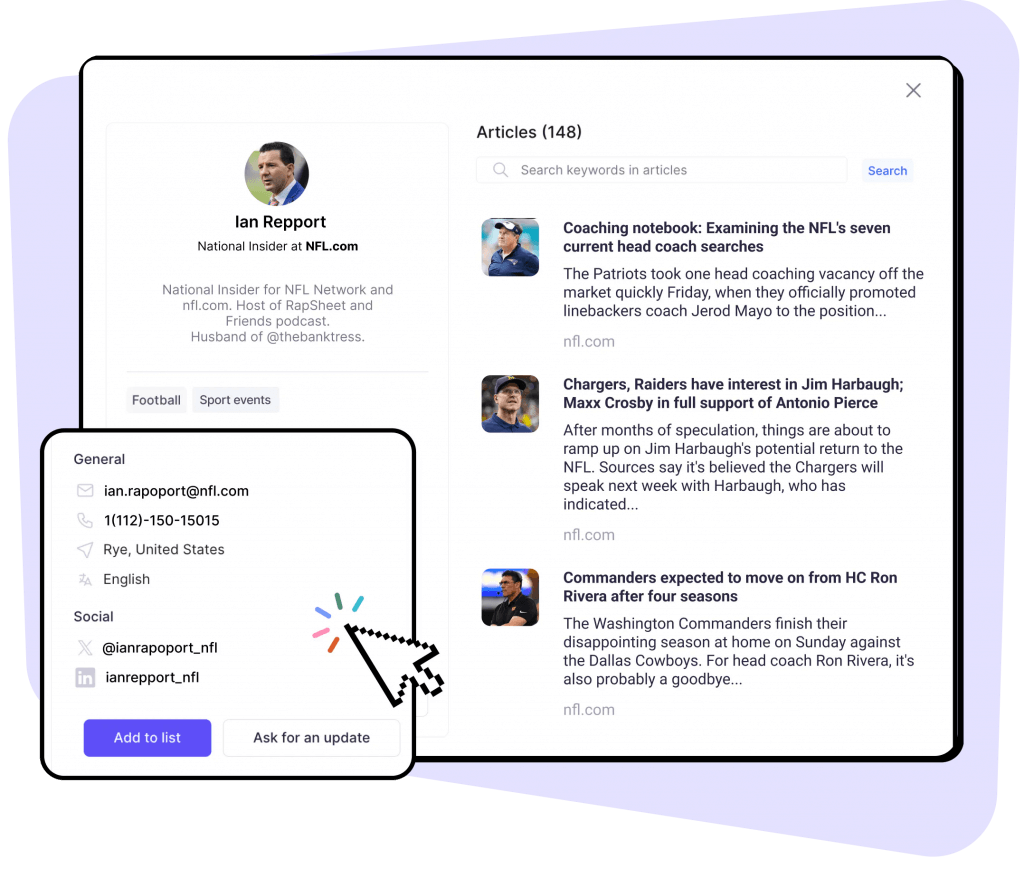A positive reputation in public relations isn't merely an advantage; it's a cornerstone of business success, especially since 95% of customers trust corporations that are well-regarded. Effective reputation management is key to keeping your business growing and on the right track.
Learn proven strategies for managing brand reputation and building trust with your customers, using tools like Prowly, in this guide for PR professionals.
Ready to start managing your reputation right away? Add media monitoring, an online newsroom, reports based on data, and more to your PR stack.
Looking for a comprehensive all-in-one PR tool?
Try Prowly completely free for 7 days in a platform with everything you need for PR.
- All-in-one software: Get everything you need in one tool for PR, incl. media database, outreach, reporting, and more
- Transparent pricing: Plans start at $258/month
- Comprehensive monitoring: Track the web and social media mentions.
What is PR reputation management?
Reputation PR is managing the opinion that your target audience has about your organization. It involves communication, actions, performance, and - most importantly - identity and values.
What’s the difference between PR and reputation management?
Both Public Relations and Reputation Management aim to shape public perception of a company. Yet, they use different methods and aim for goals which make them complementary.

👉🏼 PR primarily takes care of image and visibility. For that goal, it uses media outreach and communication: like press releases and building relationships with journalists.
👉🏼 Reputation management improves the perception of a company or individual. Its crucial role is addressing negative issues: often before they arise.
As you can see from those statements, the goal of public relations is wider, as is the scope of their actions. They include media relations, content creation, and event management. Reputation management, in turn, has more in common with crisis management. It tackles customer feedback and handles online presence.
Of course, these areas overlap - and you might even find yourself often covering both public relations and reputation management.
Still, PR is more about reaching a wider audience, and reputation management about what this audience thinks about you.
P.S. Here’s an article that might come in handy if you’re looking for a tool to measure the impact of your communication efforts.
Reputation management in PR - why should you care?
Why is reputation management important in PR? There are four good reasons:
1️⃣ Enhanced credibility and trust
Any purchase decision is easier when you trust the seller - and some are even triggered by this factor.
That's true in other business areas as well. For example, on the job market, nearly 70% of candidates would reject a job offer from a company with a bad reputation, even if they were unemployed.
2️⃣ Competitive advantage
Brand reputation is hard to emulate, and that's why it becomes such a valuable differentiator for your clients.
3️⃣ Improved customer loyalty
Reputation PR actions can foster relationships with your customer base - or drastically damage them.
In fact, changing their opinion about your company can make customers even reverse a purchase - 87% of respondents claim to have done so.
4️⃣ Financial performance
Although you can't put a precise number on your brand's reputation, it definitely influences your financial performance.
Sudden drops in your reputation will be visible even in your financial reports. Customers might choose the competition, or you may lose valuable partnerships with other stakeholders. Similarly, if you're trying to attract investors, your reputation will be a factor - apart from your results.
💡 Tip: Read this full guide on social media reputation to get a complete picture of your PR strategy.
Four components of reputation management
What are the four key steps of reputation management? Let's review them briefly:
- Monitoring: staying aware of what is said about your company.
- Response: when crisis management enters the scene - aiming to diminish the negative outcome of a situation.
- Improvement: taking insights from previous crises and using them to prevent similar situations.
- Proactive communication: remembering to take action as soon as possible, before you're obliged to.
Mastering these steps is essential for effective corporate reputation management, ensuring your brand remains resilient and trusted. You can take care of all four plus report your actions—all with just one tool designed for PR professionals. Manage all your PR with Prowly for 7 days free.
Taking control of PR reputation: examples and strategies
The issue with brand reputation is that you can't dictate what people should think about you. Nevertheless, with public relations reputation management, you can influence the conversation.
Let's see 5 strategies and (online) reputation management examples that help you achieve this goal.
#1 Strategy: proactive communication & sentiment analysis
Reputation management in public relations relies heavily on preventing a crisis from escalating. Here, your best ally is proactive communication!
You can (and should!) use tools to keep track of and analyze all mentions about your company. Most of them let you measure not only the volume of mentions, but also provide you with sentiment analysis. That's how you can quickly assess the predominant approach towards your company.
If you're looking for tool recommendations, check out our article on the best sentiment analysis tools for PR.
Find out more details about PR reputation management techniques from the dedicated PR Episodes 2023 Q&A session. You'll learn there how to identify and mitigate risks related to your company’s reputation, as well as the most effective ways of responding to any crisis.
In this 20 minute episode, Tonya McKenzie (PR & Leadership Consultant, CEO of Sand&Shores) answers all questions. Her company helps clients tell their stories, elevate their message, and build a strong reputation in the media and the communities they serve.
Or simply read our "How to Use Sentiment Analysis in PR" guide.
💡 Tip: If you want to make your PR strategy truly robust, read these articles to learn how to manage your brand reputation and protect its reputation.
👉🏼 Example: JetBlue
JetBlue faced significant operational disruptions in 2007 when a winter storm left passengers stranded on the tarmac for hours. The CEO issued a public apology and introduced a Customer Bill of Rights, which outlined compensation for any future delays. This proactive communication helped restore trust and showed their commitment to customer service.
💡 Lessons learned: Communication is not only about statements: actions you take after an incident speak much louder.
#2 Strategy: Monitoring and addressing feedback
Online PR and reputation management includes managing opinions - both the positives and negatives.
How can Media Monitoring help you out here?
- Engage Media Monitoring: Set up with Prowly’s Media Monitoring to track mentions of your brand across different channels. Monitor both traditional media and social media to gauge the public’s response to your news and actions.
- Analyze Feedback: Use insights gained from media monitoring to understand the sentiment around your brand and identify any areas needing attention.
Naturally, not all brand and topical mentions will be relevant to you. No worries!
Prowly’s AI identifies the context, sentiment, and over 15 other properties of each press hit and social mention. You can use this information to set up specific filters and ensure you'll only see the mentions that you want to see.
Examples of filters:
- Keyword combinations & context
- Topic of each mention and website (1000+ available)
- Estimated mention reach
- Region and language
- Platform (Instagram, X, Facebook, TikTok, YouTube)
👉🏼 Example: KFC
When KFC faced a chicken shortage in the UK in 2018, they responded with humor and transparency, admitting to the mishap through a rearranged "FCK" apology in a full-page newspaper ad. They continuously updated customers about the situation, effectively managing customer feedback and preventing further reputation damage.
💡 Lessons learned: Humor is valuable, but success lies in timely action and transparency.
Try Prowly's media monitoring free for 7 days
Start tracking your brand and keywords for free (no credit card required) in Prowly.
- Comprehensive monitoring: Track the web and social media mentions.
- Transparent pricing: Plans start at $258/month
- All-in-one platform: Get everything you need in one tool for PR, incl. media database, outreach, reporting, and more
#3 Strategy: rapid response in crisis
Crises always come, no matter how much you do to avoid them. In reputation management, the speed of your response is crucial.
There are two areas that play a major role in crisis management: how fast you find out about a new issue, and how prepared you are to reply.
The first area is all about alerts and media monitoring. With custom notifications, you can quickly find out when your brand reputation is in danger.

Set up email notifications for digests and alerts to get a full picture of your brand health. Create custom alerts so you can analyze any unusual spikes in mentions, monitor press hits in top-tier publications, and more.
With these notifications, you can:
- Receive recurring summaries of top mentions with key data
- Quickly react to mentions with negative sentiment
- Track trends, industry news, and competitors

Although you can't predict all possible crisis scenarios, your replies will have some elements in common. Make sure to prepare drafts of press releases in advance that you can issue in times of crisis. Prowly's Press Release Creator will help you store your drafts and craft the perfect official statement.
👉🏼 Example: Tylenol (Johnson & Johnson)
In 1982, after reports that Tylenol capsules had been contaminated with potassium cyanide and resulted in several deaths, Johnson & Johnson quickly pulled $100 million worth of product from store shelves.
They communicated openly about the steps taken to ensure public safety and introduced tamper-proof packaging, which restored public confidence and set a new industry standard.
💡 Lessons learned: Even if your reaction involves short-term costs, the impact on you brand's reputation can be much pricier.
Understanding how effective crisis management can safeguard your brand's reputation is crucial. For concrete examples of PR crises and their handling, see our article on 16 PR Crisis Management Examples.
#4 Strategy: engaging with stakeholders
Reputation PR includes taking care of your stakeholders, as they often hugely influence public opinion. Make sure to keep an updated list of all stakeholders and plan outsteps you'd take in times of crisis ahead of time.
👉🏼 Example: Starbucks
After a 2018 incident where two African American men were arrested at a Philadelphia Starbucks, the company closed over 8,000 U.S. stores to perform racial-bias education for their employees. Starbucks' engagement with stakeholders, including the affected individuals, community leaders, and the public, helped mitigate damage to their reputation.
💡 Lessons learned: Closing all stores for a day is a huge decision - and an important proof of action for stakeholders.
#5 Strategy: leveraging positive media relations
PR tools help you manage those relations. With a media database, you can cover online PR news and reputation management. Prowly gives you access to over 1M journalists' contacts, based in and outside of the U.S. It's super easy to browse: you get advanced filtering options to show only relevant contacts.

After you choose suitable contacts, you can pitch them directly from the platform - and see their important stats, like openings and replies. Building relationships is even easier with 1-1 personalized outreach!
👉🏼 Example: Microsoft
In response to concerns about government surveillance, Microsoft increased transparency about user data requests and enhanced data encryption. They communicated these steps through the media, enhancing their reputation as a protector of user privacy and strengthening media relations.
💡 Lessons learned: If Microsoft public relations reputation experts hadn't put in the time needed to create media relations, the communication plan wouldn't have worked out. Think about public relations reputation management as an investment for tougher times.
Brand values and social responsibility: key to sustainable PR reputation management
Consistent brand values
Your public reputation is rooted in company values and the coherence between your communication and choices. Remember that actions speak louder than words - as seen in this LEGO example:
👉🏼 Example: LEGO
LEGO ended its promotional contract with Shell in response to a Greenpeace campaign about Shell's environmental impact. By prioritizing its commitment to environmental sustainability over commercial interests, LEGO reinforced its brand values and maintained a positive reputation among consumers.
Reputation management PR experts on social responsibility
Willing to learn more about social responsibility? Watch PR Episodes 2023 by Prowly!

Reputation management PR experts, Molly Baker McPherson and Claire Baumann, talk about how to turn abstract concepts into concrete solutions. Both women are active CSR practitioners, helping companies make a real impact.
👉🏼 Baumann has two decades of expertise in this topic, with her background involving leadership roles at McKinsey.org, the United Nations Foundation, and the Obama Administration’s State Department.
👉🏼 McPherson is an expert in public relations and emergency management. She's a podcast host, bestselling author, and creator of a popular TikTok account that makes PR crises easy to follow and easy to avoid.
Looking for a comprehensive all-in-one PR tool?
Try Prowly completely free for 7 days in a platform with everything you need for PR.
- All-in-one software: Get everything you need in one tool for PR, incl. media database, outreach, reporting, and more
- Transparent pricing: Plans start at $258/month
- Comprehensive monitoring: Track the web and social media mentions.
Manage your reputation like a pro
Is reputation management necessary to PR strategy? It's vital, as reputation PR includes crisis management plans. Both areas are complementary, as you can't ignore the role of PR in reputation management.
That's why PR tools work like a charm - especially for digital PR brand reputation. Prowly is a modern, affordable solution designed for PR specialists. Manage media relations and take care of your reputation all in one tool!
Try Prowly for free for 7 days. No strings attached.

